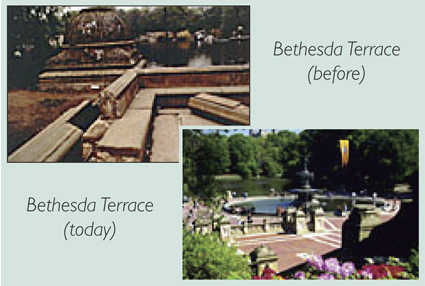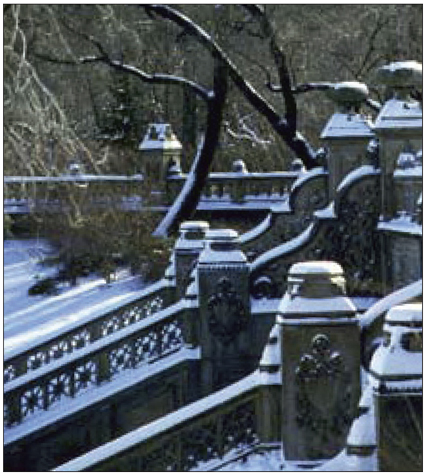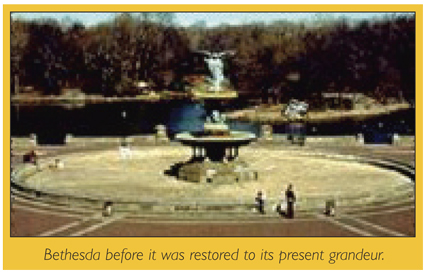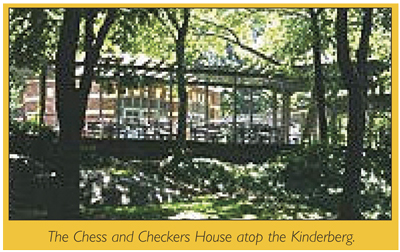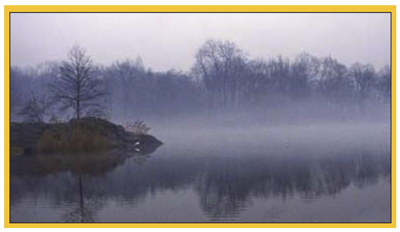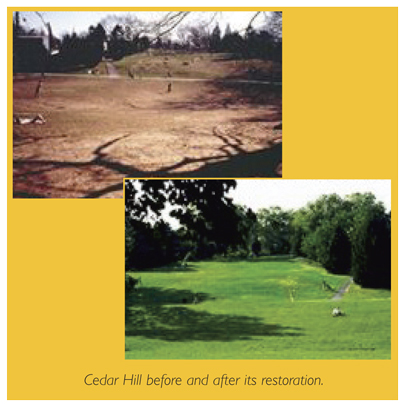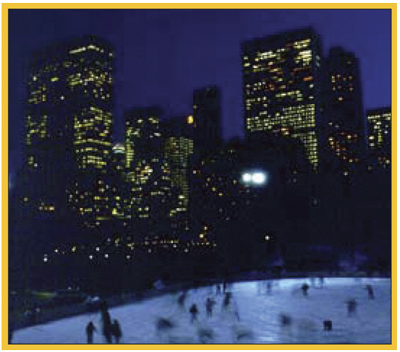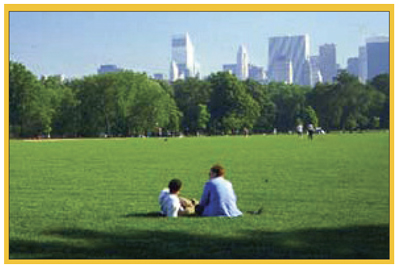CENTRAL PARK
150+ Years of Park HistoryPart 4
About the Central Park Conservancy
The Central Park Conservancy's mission is to restore, manage, and preserve Central Park, in partnership with the public, for the enjoyment of present and future generations.
The Central Park Conservancy is a private, not-for-profit organization founded in 1980 that manages Central Park under a contract with the City of New York/Department of Parks and Recreation. Thanks to the generosity of many individuals, corporations, and foundations, the Conservancy has raised more than $300 million to date and has transformed Central Park into a model for urban parks nationwide. The Conservancy provides more than 85% of Central Park's annual $23 million operating budget and is responsible for all basic care of the Park.
With 25 million visitors each year to its 843 acres, Central Park is the most frequently visited urban park in the United States. To manage the Park, Conservancy crews aerate and seed lawns; rake leaves; prune and fertilize trees; plant shrubs and flowers; maintain ballfields and playgrounds; remove graffiti; conserve monuments, bridges, and buildings; and care for waterbodies and woodlands, controlling erosion, maintaining the drainage system, and protecting over 150 acres of lakes and streams from pollution, siltation, and algae.
Conservancy at a GlanceThe Central Park Conservancy is a private, not for profit organization founded in 1980 that manages Central Park under a contract with the City of New York/Department of Parks and Recreation. Thanks to the generosity of many individuals, corporations, and foundations, the Conservancy has raised more than $300 million to date and has transformed Central Park into a model for urban parks nationwide. Since its founding, the Conservancy has prescribed a management and restoration plan for the Park; funded major capital improvements; created programs for volunteers and visitors; and set new standards of excellence in Park care.
With 25 million visitors each year to its 843 acres, Central Park is the most frequently visited urban park in the United States. The Conservancy provides more than 85% of Central Park's annual $20 million operating budget and is responsible for all basic care of the Park. Approximately four out of every five Central Park employees are funded by the Conservancy. Conservancy crews aerate and seed lawns; rake leaves; prune and fertilize trees; plant shrubs and flowers; maintain ballfields and playgrounds; remove graffiti; conserve monuments, bridges, and buildings; and care for waterbodies and woodlands, controlling erosion, maintaining the drainage system, and protecting over 150 acres of lakes and streams from pollution, siltation, and algae.
Since its founding, the Conservancy has spent over $70 million to restore most of the major Park landscapes, and has built an endowment of approximately $90 million. In 1993, a founding Conservancy Trustee offered a $17 million challenge gift for major landscape restorations in Central Park, including the West Side, the Great Lawn, and the North Meadow. Both the Conservancy and the City matched this unprecedented gift within three years, and the Conservancy went on to raise an additional $26.2 million toward operating support and endowment for the ongoing care of restored landscapes.
Conservancy public programs take advantage of the invaluable resources available in Central Park. Each year the Conservancy provides education programs focusing on environmental science, and Park history; recreation programs for youths, families, community organizations, and schools; and a volunteer program for youths and adults in horticulture and Park information services. In addition, the Conservancy organizes hundreds of free public programs throughout the year throughout the Park, primarily at the visitor centers operated by the Conservancy: The Charles A. Dana Discovery Center, Belvedere Castle, the Dairy, and the North Meadow Recreation Center.
The Conservancy also works with community and park users groups to ensure that Central Park remains an enjoyable experience for all park visitors. Groups like the Woodlands Advisory Board and Central Park PAWS meet with the Conservancy regularly to develop a sense of stewardship among all park users.
While enabling millions to enjoy the many wonders of Central Park, the Conservancy is firmly committed to maintaining and preserving New York City's treasured greensward and to educating the public to become better stewards of this irreplaceable urban treasure.
History of the Central Park Conservancy
Following is a year-by-year breakdown of the Central Park Conservancy's accomplishments since 1980. All of these accomplishments were made possible through a partnership with the City of New York and private donations from individuals, foundations and corporations and the hard work and generosity of the Central Park Conservancy's Women's Committee.
1980-1988
1980-1981
The Dairy is restored by the City of New York.
The missing loggia is rebuilt and the Dairy becomes a visitor center under the supervision of the Conservancy.
The Conservancy begins to "program" the Park; exhibitions, music series, and educational programs for children begin at the Dairy.
Initial restoration of Cherry Hill Fountain
Restoration of Bethesda Fountain
Restoration of all three fountains at the Conservatory Garden
Restoration of the Sheep Meadow by the City of New York with funds from the City of New York and the New York State Office of Parks & Recreation
Initial resodding of Pilgrim Hill
The reconstruction of rustic pergolas
1982Restoration of Belvedere Castle
Restoration of Bethesda Terrace
Relandscaping of the 5-acre site around the Dairy
Landscape restoration of the landscape surrounding the Obelisk
Restoration of Greywacke Arch
Restoration of the last remaining rustic shelter in the Ramble
Graffiti removal crew is launched
The Falconer is returned to its pedestal after a 25-year absence.
Restoration of the Point in the Ramble, including complete shoreline repair and replanting
Conservancy promotes safety lighting and designs a new and improved luminaire for the Park's 1,500 lamp posts
The Conservancy begins work on its restoration master plan, under the direction of Betsy Rogers. The goal of the plan was to produce up-to-date surveys of the Park's topography, hydrology, architectural features, circulation, drainage utilities, trees and other vegetation, along with a security analysis and Park user study.
1983
The Conservancy Women's Committee is formed after the success of the first annual Frederick Law Olmsted (FLO) Awards Luncheon. The first FLO luncheon takes place on May 3, 1983 at Tavern on the Green, and raises $172,000 for the Conservancy.
Public programs expand by leaps and bounds, with the opening of a restored Belvedere Castle on May 1, 1983. Through its public programs, the Conservancy serves 5,000 elementary school students.
Restoration of Heckscher Ballfields
May 14 and 15, 1983 marked the first "You Gotta Have Park" weekend in Central Park.
An inventory is taken of Central Park's 26,000 trees. A computerized record is created of all trees, describing their size, age, condition, and species distribution.
25 American Elms are planted on Fifth Avenue between 90th and 105th Streets to replace trees that had died over the years.New plantings and infrastructure renovations are made on the south side of the Metropolitan Museum of Art.
New landscaping at Engineers' Gate (Fifth Avenue at 90th Street).
A new rustic shelter is built at 67th Street and Fifth Avenue.
Garden designer Lynden Miller forms the Friends of the Conservatory Garden and begins to oversee the Garden's design and care.
A lawn care crew of twelve staff members, along with ten mowers and eight other pieces of lawn equipment service all of Central Park's lawns. (At the time, this was the largest fleet in years. By comparison, by 1999, the Conservancy employed a horticulture staff of 66 with a fleet of 54 lawn mowers.)
The Learning and Involvement for Volunteers in the Environment (L.I.V.E.) volunteer program begins.
A 1983 user survey reports that 80 percent of Park visitors said they came to the Park for "passive recreation" – people-watching, relaxing, thinking, reading, wandering, sunbathing, and picnicking.
1984
Restoration of Chess & Checkers House
Initial restoration of "Frisbee Hill," the landscape to the south side of the 72nd Street transverse, just north of the Mineral Springs concession.
Initial restoration of the East Green, the landscape on the south of the 72nd Street transverse, on the Park's east side.
In an effort to replenish the Park's understory vegetation, the Conservancy plants almost 12,000 plants, wildflowers and shrubs throughout the Park.
Complete reconstruction of the Girls' Gate entrance at 102nd Street and Fifth Avenue.
1,916 volunteers worked 4,091 hours in the Park.
The Frederick Law Olmsted Luncheon raises more than $200,000.
1985
The management and restoration plan, Rebuilding Central Park, is published by the Conservancy. This represents the culmination of three years of comprehensive, systematic study and analysis of the Park.
Strawberry Fields is dedicated by Mayor Koch, October 9, 1985.
The Conservancy initiates a Chess Camp.
By 1985, the Conservancy's grafitti removal crew had removed all of the accumulated graffiti of prior years, leaving it free to focus only on "fresh hits."
Repainting of the loggia at the Dairy, the ornate wrought iron gates at Conservatory Garden, and the polychrome cast-iron Ladies Pavilion at Hernshead.
Cleaning and repatinating of the sculptural gates at the Children's Zoo entrance, the statues of Romeo and Juliet and the Tempest in front of Delacorte Theater, as well as Alice in Wonderland and Hans Christian Anderson at Conservatory Water.
Rebuilding of Cop Cot, the fanciful rustic shelter mid-Park at 60th Street.
Restoration of the Gill – the stream running through the Ramble – including the reconstruction of a rustic bridge.Steps at Conservatory Garden repointed.
Various sections of the Park wall repaired.
Renovation of eroded lawns at West 62nd Street entrance.
Planting of more than 1,400 understory trees and shrubs, 3,500 groundcover plants, and 7,500 wildflowers.
Conservancy volunteers log a total of 8,202 hours in the Park.
Bow Bridge repainted.
Clay surface installed on Rumsey Playfield.
1986
A new picnicking area is created when the cracked, derelict and abandoned game courts on the Great Hill, at 106th Street and Central Park West, are cleared away and a new meadow is seeded.
SummerStage, originally a Conservancy-sponsored entertainment series, begins at the Bandshell.
Heckscher Ballfields receive a facelift.
The closed roadway or "Dead Road" on the east side of Sheep Meadow is repaved with 1,650 square yards of asphalt, for disco-dancing roller skaters.
Reconstruction of the Billy Johnson Playground at East 67th Street.
Restoration begins at Engineers' Gate – 90th Street and Fifth Avenue.
Installation of new sod, 50 new trees, 3,500 shrubs and 3,000 ground cover plants at Bethesda Terrace.
The statue of Polish King Wladyslaw Jagiello on the Great Lawn at 79th Street is cleaned and repatinated.
Rebuilding of the pergola at the Mall.
Rebuilding of the pergola at Conservatory Garden.
William S. Beinecke steps down as Chairman of the Central Park Conservancy, and James H. Evans steps up to the plate as the new Chairman.
1987Conservancy volunteers log a total of 9,713 hours in the Park.
The initial restoration of Cedar Hill.
Restoration of the East 76th Street Playground (James Michael Levin Playground).
Restoration of the West 81st Street Playground (Diana Ross Playground)
Installation of new playground equipment at the East 67th Street Playground.
At Bethesda Terrace, two magnificent banner poles bearing gonfalons – a sight New Yorkers had heretofore seen only in nineteenth century paintings and prints – were refabricated and reinstalled by the edge of the Lake.
The Fifth Annual Frederick Law Olmsted Luncheon raises more than $300,000.
The Campaign for the Central Park Conservancy begins, and is chaired by Henry R. Kravis.
The campaign to restore Grand Army Plaza begins.
1988
Restoration of Inventors' Gate and its surrounding landscape (East 72nd Street).
The restoration of the boat landing at Hernshead, including the restabilization of the shore edge and the reconstruction of the paths and the drainage system from the West Drive to the Lake.
Ongoing restoration of the Kinderberg, or Childrens' District, surrounding the Dairy.
The Conservancy initiates the redesign and reclamation of the Harlem Meer.
Conservancy volunteers log a total of 13,000 hours in the Park. The Conservancy's volunteer program wins a citation for excellence from the White House.
The Conservancy's restoration crew restores Glade Arch, north of Conservatory Water. The crew repairs the arch's sandstone balustrade, retools its remaining stonework and replaces approximately 6,500 damaged bricks.
The Shakespeare Garden is redesigned and expanded. The Conservancy's restoration crew repaves pathways and stairs, installs rustic wooden benches and rustic cedar railings.
The Conservancy cleans and repatinates Angel of the Waters, the statue at Bethesda Fountain, which had become encrusted with corrosive copper sulfate.
To help secure the Park from future cycles of decline and to reduce the subsequent demand for capital restoration, the Conservancy establishes the Greensward Trust, an endowment fund, with income dedicated to Park maintenance.
1989-1992
1989
Restoration of Playmates' Arch – the Arch that links the Dairy and the Carousel.
Restoration of Bridge No. 24 – the last of five cast iron bridges in the Park restored.
The 7th Annual Frederick Law Olmsted Luncheon raises a record $592,000.
Restoration of the West 67th Street Adventure Playground.
This year, the Conservancy completes the restoration of the Park's 130-year old cast iron bridges, with the restoration of Bridge 24, located on the Bridle Path near East 86th Street.
The Conservancy begins to develop a comprehensive environmental plan to manage the Park's three major woodlands: the Hallett Nature Sanctuary, the Ramble, and the North Woods.
The building of the West 72nd Street rustic arbor.
New entrance piers are added at the Park's entrance at 59th Street and Fifth Avenue.
Restoration and relandscaping of the terrace of the 3,600 year-old Obelisk near the Great Lawn. The monument is now illuminated, and new benches, paving, and landscaping have transformed the spot into a small sitting garden.
Restoration of the landscapes between West 86th and West 90th Streets.
Conservancy volunteers log 11,500 work hours in the Park.
The Conservancy announces a $50 million Capital Campaign.
1990
Chaired by Ira Millstein, the Conservancy's Citizen's Task Force on the Use and Security of Central Park conducts the most exhaustive study ever undertaken of safety in an urban Park. The report includes 50 recommendations that challenge the Conservancy to pursue new programming directions and expedite restoration of the Park.
The dredging of the Harlem Meer is the first step in restoring this exceptionally beautiful but neglected landscape. The Conservancy removes 34,000 cubic yards of sediment and debris from the lake bed and replaces the valves that regulate the water level.
The restoration of Grand Army Plaza, including Pulitzer Fountain, the bronze equestrian statue of General William Tecumseh Sherman, and the Plaza itself.
The bronze statue of José Martí, the Cuban poet and patriot, at Sixth Avenue and Central Park South, is refurbished and rededicated on October 10, 1990.
Volunteers greet Park visitors at a new kiosk.
The Ballplayers House at Heckscher Ballfields at 65th Street is completed. This new building replaces an original Park structure that stood from 1873 to 1969.
Daily recreation programs begin at North Meadow Recreation Center.
The first season of Camp Central Park.
The Conservancy's Capital Campaign reaches $42.5 million.
The Carousel landscape and surrounding plaza are restored.
In its ongoing restoration of the Mall — the Park's only formal promenade — the Conservancy has added new planting beds at the southern entrance, as well as new hexpaving, and a pipe rail fence to protect the Mall's precious elm trees.
Schoolchildren made nearly 10,000 visits to at least one of the education programs at the Dairy, Belvedere Castle, and the Park's North End.
New plantings at the Billy Johnson Playground at East 67th Street and Fifth Avenue.
The Woodland Management Advisory Board is formed to develop strategies and monitor the care of the park's 130 acres of woodland.
The Pat Hoffman Friedman Playground at East 79th Street is dedicated, with the unveiling of the playground's centerpiece, a bronze statue Group of Bears by Paul Manship.
1991
The Campaign for the Central Park Conservancy comes to an end after a five-year effort. The Campaign, which was chaired by Conservancy trustee Henry R. Kravis, raised more than $50 million for Central Park.
The restoration of the Mall is completed: Literary Walk is restored; new benches that replicate the original design by Calvert Vaux encircle the planting islands near the Bandshell; an endowment fund is created for a zone gardener to maintain the Mall.
The installation of 24 trompe l'oeil panels painted by Lucretia Moroni in the niches of the Bethesda Terrace arcade.
Green Gap and Driprock Arches, located on the Park Drive to the east and west of Wollman Rink, are restored. The Conservancy located, and succeeded in having reopened quarries in New Brunswick, Canada, which supplied the original sandstone for the arches.
The Greensward Trust endowment fund reaches $7 million.
The Women's Committee establishes the Adopt-A-Bench program.
Funds from the Women's Committee's Frederick Law Olmsted Luncheon create an endowment at the Dene, located along Fifth Avenue between 66th and 71st Streets.
The Central Park Tree Trust is established, to form an endowment fund for tree care, and to protect Central Park's trees — one of the finest collections of trees in any urban park in the nation.
The restoration of the landscapes on the south side of the Metropolitan Museum of Art.
The completion of the Bernard Family Playground at East 108th Street.
More than 12,000 students participate in the Conservancy's education programs.
A rock-climbing wall is added to the North Meadow Recreation Center.
Three half-basketball courts are added to the North Meadow Recreation Center.
James H. Evans steps down as Chairman of the Central Park Conservancy, and Ira M. Millstein is elected as Chairman.
1992
The restoration of the arches, cascades and surrounding landscapes of Glen Span Arch and Huddlestone Bridge.
Playground Partners, a Women's Committee program, is inaugurated and raises more than $100,000 for playground maintenance.
Three new roving crews are created: one for playground maintenance, another for upkeep of historic structures, and a third for bronze conservation.
The loggia at the Dairy is repaired and repainted. The Dairy, an original Park building designed by Calvert Vaux, had been shorn of its beautiful loggia for several decades prior to its restoration in 1980. However, until a gift established the new maintenance crew, the Conservancy had no ability to provide ongoing routine maintenance for this and other historic Park structures.
Fourteen of the Park's 50 historic bronze structures are cleaned and rewaxed.
Two new zone gardeners are hired in 1992, bringing the total number of such site-specific workers to ten. These zone gardeners work at Conservatory Water and the Mall.
The Rudin Family Playground is built at West 97th Street.
The Abraham & Joseph Spector Playground at West 86th Street is refurbished with new water features and play equipment.
The Conservancy breaks ground for the new Charles A. Dana Discovery Center at 110th Street between Fifth and Lenox Avenues.
A record 3,700 individuals volunteer in the Park this year, donating 27,500 hours of service.
The Conservancy adds an indoor climbing wall at the North Meadow Recreation Center to supplement cold- or rainy-weather programs.
1993-1997
1993
To date, the Conservancy's award-winning designers have initiated the restoration of more than half the Park's landscapes and historic structures.
Richard Gilder, a Conservancy Trustee and lifelong New Yorker, offers an unprecedented $17 million challenge grant to restore major landscapes of Central Park. In response to Mr. Gilder's generosity, the City of New York agrees to meet his challenge, pledging another $17 million in matching funds. His gift is finally contingent upon $17 million in private contributions, which are to be raised by the Conservancy during the next three years. This campaign is chaired by Daniel P. Tully.
The challenge is specifically to address: new playgrounds, lawns benches, drinking fountains, and paths on the Park's west side; the Great Lawn; the North Meadow Recreation Center and North Meadow Ballfields; and the upgrading of drainage and other Park infrastructure.
The 11-acre Harlem Meer and surrounding landscape are reopened, with a new wildlife habitat island.
The Charles A. Dana Discovery Center, which will provide environmental education programs and activities, and information to visitors, officially opens.
The new Lila Wallace-Reader's Digest Terrace adjacent to the Dana Center, offers an informal area for outdoor performances.
New play equipment is installed at the Playground at 110th Street and Central Park West.
A Woodlands Manager is assigned to the North Woods, and the Woodlands Crew increases from two to five people.
The Conservancy reintroduces more than 40 species of native wildflowers, shrubs and trees to the North Woods.
New plantings at Wien Walk and new benches at Wallach Walk.
The reconstruction of the East 85th Street Park entrance.
At 60th Street and Fifth Avenue, the Conservancy restores the Doris C. Freedman Plaza, a setting for exhibitions of contemporary sculpture.
Wagner Cove, on the Central Park Lake east of Strawberry Fields, is beautified with shoreline plantings. The cove is a memorial to the late mayor Robert Wagner.
The restoration of the terrace at Kerbs Boathouse at Conservatory Water includes new benches and fencing, and a restored landscape.
The bronze conservation crew completes comprehensive treatments of five bronze statues on the Mall, the Untermyer Fountain at Conservatory Garden, and three additional bronze statues throughout the Park.
The Historic Preservation Crew repairs the perimeter wall at numerous locations along the perimeter and replaces steps at the Great Hill.
In 1993, 20 Conservancy education programs take place in the Park, serving 20,000 students.
1994The Conservancy receives three awards for its work on the Harlem Meer and The Charles A. Dana Discovery Center: the 1994 New York City Landmarks Preservation Award, the American Society of Landscape Architects' Design Merit Award, and the Victorian Society's Citation of Merit.
The restoration of Winterdale Arch at West 81st Street includes the reconstruction of the cast-iron balustrades that had been missing for 50 years.
The reconstruction of the southwest corner landscape reconfigures the confusing tangle of pedestrian paths from West 62nd to 66th Street to direct people more conveniently to popular lower-Park destinations.
A new pedestrian entrance is opened at West 63rd Street, lawns planted, and lighting installed.
Restoration of the landscapes from West 106th to West 108th Streets, including a plaza at West 106th Street and a pedestrian entrance at West 108th Street that connects to a path to the Great Hill, as well as new benches, plantings, open lawns, and an improved drainage system.
The perimeter landscape from West 97th to 100th Streets is restored to its historic character, with new pathways, benches, and rebuilt rustic stone fences.
Renovation of the East 96th Street Playground, with colorful new play equipment, a new toddler area and a rubber safety surface.
New plantings and benches at the East 76th Street Park entrance.
Restoration of a picturesque woodland and meadow-like garden at the Sixth Avenue and Central Park South entrance.
The Women's Committee's 1994 Frederick Law Olmsted Awards Luncheon raises $690,000 for horticulture, security, and programs for visitors.
The Monuments Conservation Crew repairs the Burnett "Secret Garden" fountain at the Conservatory Garden, so that water flows for the first time in 30 years.
Structural repairs are made to Central Park's historic Carousel and the building that houses it.
Conservancy volunteers log 30,000 hours of service in Central Park.
1995Restoration of Greyshot Arch at West 61st Street.
Restoration of West 81st Street entrance, establishes an expanded seating area with new benches that embrace a London plane tree.
The relocation of the pedestrian entrance at West 62nd Street to West 63rd Street, better leads visitors to Heckscher Ballfields and other points east.
Pedestrian pathways near Columbus Circle are repaved to create a recreational pathway for pedestrians, inline skaters, bicyclists and joggers, providing access to the Drive.
The restoration of Cedar Hill, one of the Park's most heavily-trafficked landscapes, popular with dog walkers and sledders.
The Conservancy's Office of Government & Community Affairs works closely with Park users to create a new flag system to alert parkgoers to wet turf conditions so that visitors keep off the grass when it is vulnerable to damage.
Conservancy volunteers spend more than 26,000 hours donating their services.
The Conservancy's Monuments Conservation Crew restores the fanciful Delacorte Clock at the Zoo.
The Conservancy's Monuments Conservation Crew replaces 14 lost bird heads and 23 broken carvings at Bethesda Terrace.
The Conservancy's Historic Preservation Crew replaces all 16 columns on the loggia of Belvedere Castle.
The Women's Committee's 13th Annual Frederick Law Olmsted Luncheon raises a record $1.3 million.
The North Meadow Recreation Center draws almost 27,000 teenage visitors this year. They played basketball or handball, took tennis clinics, or rock climbing classes and played chess and ping pong.
Almost 12,000 people borrow fishing poles at the Charles A. Dana Discovery Center.
The Conservancy formally adopts the zone management plan, which divides the Park into 49 zones, each maintained by at least one zone gardener trained in horticulture and responsible for all aspects of the management and maintenance of his or her zone. The zone gardeners are assisted by specialized Parkwide crews, including tree, bench, and playground care, graffiti removal, monuments conservation, historic preservation, soil and water conservation, and storm water management. This new system ensures improved cleanliness and productivity throughout the Park.
1996The successful conclusion of the three-year, $71.5 million Wonder of New York Campaign, which matched the Gilder Challenge. The overwhelming support of thousands of new Yorkers and many corporations and foundations enables the Conservancy to exceed its goal by approximately $5.7 million, raising nearly $77.2 million.
The Conservancy embarks on its single most ambitious landscape restoration and the centerpiece of the Wonder of New York Campaign – the restoration of the 55 acres including and surrounding the Great Lawn and Turtle Pond.
At Summit Rock at West 83rd Street, the highest natural point in the Park, a long-abandoned cement sandbox from the Robert Moses era is replaced by a picturesque amphitheater and rocky overlook.
Naturalists' Walk, a nature education landscape from West 77th to West 81st Street, is completed.
The completion of Azalea Walk, a beautiful landscape along the slopes of Eaglevale Bridge from West 74th to West 77th Streets, with an array of colorful azaleas, rhododendrons, and other native flora.
Renovation of the Adventure Playground at West 67th Street.
The restoration of the West 68th Street landscape – the location of the finish line for the New York City Marathon.
Conservancy volunteers give 35,000 hours of their time to Central Park this year.
The restoration of the Maine Monument at Merchants' Gate – 59th Street and Eighth Avenue, Columbus Circle.
The restoration of the Sixth and Seventh Avenue Park entrances, including the reconfiguring of pedestrian pathways and the planting of surrounding landscapes.
The restoration of Dipway Arch, mid-Park at 60th Street.
Opening of the Henry Luce Nature Observatory at Belvedere Castle, with colorful, hands-on exhibits on the rich variety of animals and plants that exist in Central Park.
The main-floor Discovery Room of The Charles A. Dana Discovery Center is converted into a community gallery for rotating educational exhibits.
Conservancy workers skilled in rustic wood construction recreate a rustic wooden footbridge at Naturalists' Walk, and construct 400 feet of rustic railing at Summit Rock.
Karen H. Putnam becomes President of the Central Park Conservancy, and Betsy Barlow Rogers steps down after 16 years in this role.
1997
The 55-acre restoration of the Great Lawn, Turtle Pond and surrounding landscapes is complete. After two years of construction and an investment of $18.2 million, the 55-acre area features new amenities for sports enthusiasts and nature lovers.
Restoration of Merchants' Gate Plaza. The area is transformed into an attractive and inviting public plaza with decorative granite paving, a low stone seating wall, clearly defined pedestrian entrances and a shaded sitting area with improved lighting.
More than 15,000 young people participated in after-school fitness, recreation and basketball programs at the North Meadow Recreation Center.
Central Park's visitor centers attract nearly half a million people this year.
The Frederick Law Olmsted Awards Luncheon raises $1.3 million.
Conservancy crews repair 2.4 miles of benches with the assistance of volunteers.
The Conservancy completes a feasibility study for the restoration and re-installation of the historic Minton Tile ceiling at Bethesda Terrace arcade.
The restoration of the "Safari" Playground at West 91st Street with treehouses and hippopotamuses playing in a safety surface "river."
The Robert Bendheim Playground at East 100th Street is the first in Central Park specifically designed for both able-bodied and disabled children.
Restoration of the Olmsted Bed at the end of Literary Walk.
The Conservancy begins its Central Park Challenge, a professional development program offering leadership and team-building opportunities to the City's corporate community.
Alexander P. Papamarkou donates $500,000 to endow a zone gardener for the Pond in memory of his mother, Margot.
1998-2002
1998
In February, Chairman Ira M. Millstein signs, with Mayor Rudolph W. Giuliani and Parks & Recreation Commissioner Henry J. Stern, the most important agreement in Conservancy history – an eight-year management contract that officially makes the Conservancy "Keeper of the Park."
The Conservancy receives the single largest institutional grant in its 18-year history – a $10 million gift from the Uris Brothers Foundation. The grant provides capital funds for the improvement of visitor center facilities, the restoration of landscapes, and for public programming, including recreation, education and family and community programs.
The Conservancy reconstructs the 2.58-mile Reservoir running track.
The Conservancy begins an extensive $4.6 million project to rebuild the 20-acre North Meadow, a popular Park locale with 12 baseball-softball fields and five soccer-football fields.
The Conservancy receives a national award from the American Society of Landscape Architects for design excellence in the reconstruction of the Great Lawn.
The Conservancy receives the Philip N. Winslow Landscape Design Award for the reconstruction of the Merchants' Gate Plaza entrance.
1999
Dedication of the nautically-themed Mariners' Playground at West 84th Street at Mariners' Gate.
The Conservancy officially reopens the North Meadow Recreation Center. Previous classroom space is doubled. Exercise equipment, new indoor and outdoor climbing walls, and computers for analyzing individual fitness data are added.
The Conservancy begins design work to modernize the East 72nd Street Playground.
The Conservancy begins design work to restore the Pond at 59th Street and Fifth Avenue.
Ira M. Millstein steps down as Chairman of the Central Park Conservancy, and A.J.C. Smith becomes the new Chairman.
2000
The North Meadow reopens after a two-year restoration providing 12 beautiful baseball and softball fields for use in the spring, and six soccer fields for use in the fall.
Karen H. Putnam resigns after five years as the Conservancy's president having completed all the projects included in the Wonder of New York capital campaign.
Conservatory Water reopens after a six-month restoration to make necessary repairs and replace crumbling concrete coping with beautiful "Atlantic Blue" granite.
Construction begins on the restoration of one of Central Park's most visible and heavily used landscapes, the 59th Street Pond.
An innovative after-school program funded by The Henry Luce Foundation, Inc. is launched in the fall to help at-risk teens from the Bilingual Bicultural Middle School in East Harlem. The yearlong program uses rock climbing with academic enrichment activities to promote personal development.More than 570,000 children, teens, and adults participate in the Conservancy’s free recreation, education, visitor, volunteer, and family and community programs.
The original 19th-century gate names are inscribed along the Park's perimeter.
The $2.5 million restoration of the Reservoir landscapes is completed, thanks to a grant from the Uris Brothers Foundation.
The Chairman's Circle, composed of individuals who make an annual unrestricted contribution of $25,000 or more, is founded to support the outstanding horticulture and maintenance work of the Conservancy. The Olmsted Society, named for the pioneering landscape architect who, in partnership with Calvert Vaux, designed Central Park, recognizes and thanks those friends who have expressed concern for the future of the Park by including the Conservancy in their estate plans.
$5.86 million is raised by the Women's Committee, including more than $1 million through the Adopt-A-Bench program.
2001
In May, the Conservancy welcomes Regina S. Peruggi as its new president. With a background in education, she plans on making that a cornerstone of her tenure.
Seneca Village, a settlement once located in the Park and founded in the 1820s, is commemorated as the first prominent community of African-American property owners in New York City.
An aging irrigation system under Sheep Meadow is replaced to reduce erosion and to keep the lawn healthy, made possible by a grant from The Marc Haas Foundation.
The $1.5 million reclamation of the Pool is undertaken thanks to a generous anonymous gift.
In memorial to the victims of the September 11, 2001 attack on the World Trade Center, 40,000 daffodil bulbs are planted in Central Park
Central Park Conservancy staff tie ribbons of remembrance to more than 450 light posts lining the Park drives as a symbol of spirit, remembrance, and honor.
The Conservancy is jointly awarded, with three other organizations, the 2001 Award for Outstanding Commitment to the Preservation and Care of Collections by The American Institute for Conservation and Artistic Works (AIC) and Heritage Preservation.
A Daffodil Program to support the Conservancy is launched by Women’s Committee.
The Women’s Committee celebrates Playground Partners' 10th anniversary.
A water trough for horses rededicated in by the Conservancy, New York City/Parks & Recreation, and the American Society for the Prevention of Cruelty to Animals (ASPCA).
2002
The $4 million reconstruction of the Pond is completed, and it reopens after an eighteen-month renovation, thanks to the generosity of Julian and Josie Robertson.
The Conservancy is awarded a $300,000 grant from The Andrew W. Mellon Foundation for care and maintenance in the Park over the next year.
Anti-infestation measures are enacted for monitoring of the Asian Longhorned beetle in Central Park. New Yorkers are recruited and trained by Conservancy and USDA to help in spotting the wood-boring pest.
A new genus and species of centipede is discovered in Central Park. The centipede is about four-tenths of an inch long, making it one of the smallest in the world. The creature -- Nannarrup hoffmani , named for the man who discovered it -- lives in the park's leaf litter, the crumbling organic debris that accumulates under the trees.
Conservancy volunteers log 30,000 hours of service in Central Park.
2003-Present
2003
Annual visitation to Central Park reaches 25 million people.
July 21, 2003 marks Central Park's 150th Anniversary that the Conservancy celebrates with year-round events.
The Central Park Conservancy completes work on the new Reservoir Fence, a $2 million capital project to replace the old chain-link fence with a replica of the 8,170 foot steel and cast-iron fence that enclosed the Reservoir in 1926. The fence, and the removal of invasive trees and shrubs, restores the stunning panoramic views of the Park and the Manhattan skyline.
The $1.5 million restoration of the Pool, supported by a generous gift to the Conservancy, is completed. The Pool's features were enhanced: new settee benches and path lights were installed, the site was graded, and attractive aquatic plants were introduced at the water's edge.
Conservancy volunteers contribute 21,000 hours of their time to working in the Park.
2004
Work begins on the restoration of the Heckscher Playground, the first step toward restoring the entire 30-acre historic playground landscape including a building, ballfields, meadows, and rock outcroppings.
Conservancy staff and contractors begin work on the restoration of the Minton Tiles that hang in the ceiling of the Bethesda Arcade to return them and the arcade back to their original glory.
President Regina Peruggi resigns after three years. Central Park Administrator Doug Blonsky assumes the top position while retaining the joint role of Administrator.
Conservancy volunteers spend 32,200 hours in Central Park helping field staff keep the Park beautiful.
Part 5: Horse-Drawn Carriages and Central Park Photography
NAVIGATION: INDEX • ADVERTISER DIRECTORY • ARCHIVES •
• INDUSTRY TRADE ASSOCIATIONS • CONTACT •
COPYRIGHT © 2006 TLC MAGAZINE ONLINE, INC.

